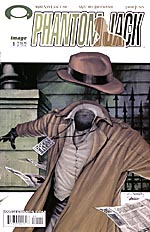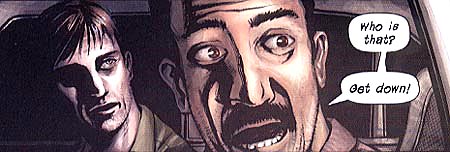 Written by Mike San Giacomo
Written by Mike San Giacomo
Art by Mitchell Breitweiser
32 pages, color
Published by Image Comics
I’ll admit it, I read Phantom Jack #1 in spite of myself. The idea itself seemed perfectly ordinary—reporter can turn himself invisible—but what really grabbed my attention was creator Mike San Giacomo’s removing the book from Marvel’s stillborn Epic line and taking it to Image Comics. Between that and San Giacomo’s stream of online columns about the creation of the book, there was so much attention focused on the mechanics of the title and almost none about the actual content that it seemed to demand a review. Ultimately the question becomes, is Phantom Jack really worth all the fuss?
In April 2002, Jack Baxter was one of many journalists in Iraq, reporting on the search for weapons of mass destruction in the country. While there, one of his sources was dragged off to his death before Jack’s very eyes, an event that is haunting him a year later. Now back home and a reporter for The Clarion, Jack is still partially paralyzed by those events, until the day where he finds himself understanding that with great powers ultimately comes great responsibility.

In an editorial at the end of Phantom Jack #1, San Giacomo all but apologizes for the contents of the issue, saying that it is “the result of rewrites and suggestions from Marvel, some good and some bad” and how if he had more time he’d have rewritten the book. This is, to be blunt, a little ludicrous. When San Giacomo decided to take the book to Image Comics, he also had the opportunity to set his own schedule and decide when he wanted his book to debut. Phantom Jack #1’s successes and failures are ultimately pinned on the creative staff, and if this is how they chose to release the book, then so be it. What I’m leading up to is the unsurprising revelation that Phantom Jack is less than impressive. The pace is plodding and dull, and Jack himself comes across as a “Mary Sue” character with a bit of Spider-Man’s origin grafted on. Almost everyone loves Jack, and those who talk ill of him (in a scene so unconvincing one almost hopes there’s a revelation that it was staged for Jack’s benefit) are quickly slapped down and shown the error of their ways. There’s nothing here you haven’t seen before, only with weak dialogue that sounds so stilted and unnatural it’s laughable.
 Artist Mitchell Breitweiser is an all right, if not terribly spectacular artist. His real strength here is that he’s got a good eye for page layout and panel-to-panel storytelling. He’s got a real sense of how to tell a story, and to keep a reader’s eye moving across the page. This is a skill that most new artists seem to lack these days, so it’s nice to see a relatively new creator already come into the comics industry with this sort of understanding. On the downside, though, Breitweiser draws people’s faces so strangely it’s actually distracting. Every time Jack appears, his face is oddly glazed over like he’s just injected heroin into his veins a couple of minutes earlier. Adding in strange poses and stances by characters (the Iraqi soldiers dragging Aziz to their death, for instance, seem to be standing on slippery floors that are causing them to involuntarily do the splits) and some bizarre anatomy (the heroin seems to make Jack’s neck grow) and the entire comic ends up looking nothing short of odd. In a book that (aside from a certain invisibility power) tries to ground itself in the real world, being unable to draw people is a bit of a hindrance.
Artist Mitchell Breitweiser is an all right, if not terribly spectacular artist. His real strength here is that he’s got a good eye for page layout and panel-to-panel storytelling. He’s got a real sense of how to tell a story, and to keep a reader’s eye moving across the page. This is a skill that most new artists seem to lack these days, so it’s nice to see a relatively new creator already come into the comics industry with this sort of understanding. On the downside, though, Breitweiser draws people’s faces so strangely it’s actually distracting. Every time Jack appears, his face is oddly glazed over like he’s just injected heroin into his veins a couple of minutes earlier. Adding in strange poses and stances by characters (the Iraqi soldiers dragging Aziz to their death, for instance, seem to be standing on slippery floors that are causing them to involuntarily do the splits) and some bizarre anatomy (the heroin seems to make Jack’s neck grow) and the entire comic ends up looking nothing short of odd. In a book that (aside from a certain invisibility power) tries to ground itself in the real world, being unable to draw people is a bit of a hindrance.
In the end, I think it’s a good thing for San Giacomo and Breitweiser that they were able to pull Phantom Jack from the collapse of Epic Comics and bring it over to Image Comics. Not because the book was in desperate need to be published, but because people are able to focus on the drama and industry shuffling that happened with the comic. In the end, that’s far more interesting than the actual book.
